Yikai Zhang
The Lighthouse of Language: Enhancing LLM Agents via Critique-Guided Improvement
Mar 20, 2025Abstract:Large language models (LLMs) have recently transformed from text-based assistants to autonomous agents capable of planning, reasoning, and iteratively improving their actions. While numerical reward signals and verifiers can effectively rank candidate actions, they often provide limited contextual guidance. In contrast, natural language feedback better aligns with the generative capabilities of LLMs, providing richer and more actionable suggestions. However, parsing and implementing this feedback effectively can be challenging for LLM-based agents. In this work, we introduce Critique-Guided Improvement (CGI), a novel two-player framework, comprising an actor model that explores an environment and a critic model that generates detailed nature language feedback. By training the critic to produce fine-grained assessments and actionable revisions, and the actor to utilize these critiques, our approach promotes more robust exploration of alternative strategies while avoiding local optima. Experiments in three interactive environments show that CGI outperforms existing baselines by a substantial margin. Notably, even a small critic model surpasses GPT-4 in feedback quality. The resulting actor achieves state-of-the-art performance, demonstrating the power of explicit iterative guidance to enhance decision-making in LLM-based agents.
PowerAttention: Exponentially Scaling of Receptive Fields for Effective Sparse Attention
Mar 05, 2025Abstract:Large Language Models (LLMs) face efficiency bottlenecks due to the quadratic complexity of the attention mechanism when processing long contexts. Sparse attention methods offer a promising solution, but existing approaches often suffer from incomplete effective context and/or require complex implementation of pipeline. We present a comprehensive analysis of sparse attention for autoregressive LLMs from the respective of receptive field, recognize the suboptimal nature of existing methods for expanding the receptive field, and introduce PowerAttention, a novel sparse attention design that facilitates effective and complete context extension through the theoretical analysis. PowerAttention achieves exponential receptive field growth in $d$-layer LLMs, allowing each output token to attend to $2^d$ tokens, ensuring completeness and continuity of the receptive field. Experiments demonstrate that PowerAttention outperforms existing static sparse attention methods by $5\sim 40\%$, especially on tasks demanding long-range dependencies like Passkey Retrieval and RULER, while maintaining a comparable time complexity to sliding window attention. Efficiency evaluations further highlight PowerAttention's superior speedup in both prefilling and decoding phases compared with dynamic sparse attentions and full attention ($3.0\times$ faster on 128K context), making it a highly effective and user-friendly solution for processing long sequences in LLMs.
MCiteBench: A Benchmark for Multimodal Citation Text Generation in MLLMs
Mar 05, 2025Abstract:Multimodal Large Language Models (MLLMs) have advanced in integrating diverse modalities but frequently suffer from hallucination. A promising solution to mitigate this issue is to generate text with citations, providing a transparent chain for verification. However, existing work primarily focuses on generating citations for text-only content, overlooking the challenges and opportunities of multimodal contexts. To address this gap, we introduce MCiteBench, the first benchmark designed to evaluate and analyze the multimodal citation text generation ability of MLLMs. Our benchmark comprises data derived from academic papers and review-rebuttal interactions, featuring diverse information sources and multimodal content. We comprehensively evaluate models from multiple dimensions, including citation quality, source reliability, and answer accuracy. Through extensive experiments, we observe that MLLMs struggle with multimodal citation text generation. We also conduct deep analyses of models' performance, revealing that the bottleneck lies in attributing the correct sources rather than understanding the multimodal content.
Multi-agent KTO: Reinforcing Strategic Interactions of Large Language Model in Language Game
Jan 24, 2025Abstract:Achieving Artificial General Intelligence (AGI) requires AI agents that can not only make stratigic decisions but also engage in flexible and meaningful communication. Inspired by Wittgenstein's language game theory in Philosophical Investigations, we propose that language agents can learn through in-context interaction rather than traditional multi-stage frameworks that separate decision-making from language expression. Using Werewolf, a social deduction game that tests language understanding, strategic interaction, and adaptability, we develop the Multi-agent Kahneman & Tversky's Optimization (MaKTO). MaKTO engages diverse models in extensive gameplay to generate unpaired desirable and unacceptable responses, then employs KTO to refine the model's decision-making process. In 9-player Werewolf games, MaKTO achieves a 61% average win rate across various models, outperforming GPT-4o and two-stage RL agents by relative improvements of 23.0% and 10.9%, respectively. Notably, MaKTO also demonstrates human-like performance, winning 60% against expert players and showing only 49% detectability in Turing-style blind tests. These results showcase MaKTO's superior decision-making, strategic adaptation, and natural language generation in complex social deduction games.
Reweighting Improves Conditional Risk Bounds
Jan 04, 2025


Abstract:In this work, we study the weighted empirical risk minimization (weighted ERM) schema, in which an additional data-dependent weight function is incorporated when the empirical risk function is being minimized. We show that under a general ``balanceable" Bernstein condition, one can design a weighted ERM estimator to achieve superior performance in certain sub-regions over the one obtained from standard ERM, and the superiority manifests itself through a data-dependent constant term in the error bound. These sub-regions correspond to large-margin ones in classification settings and low-variance ones in heteroscedastic regression settings, respectively. Our findings are supported by evidence from synthetic data experiments.
Revealing the Barriers of Language Agents in Planning
Oct 16, 2024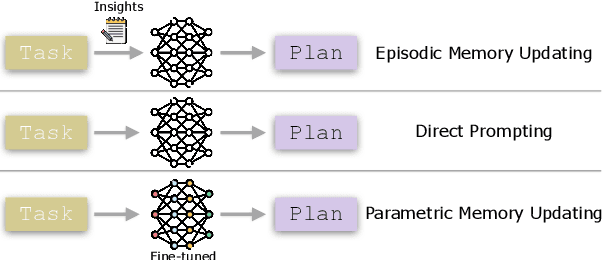
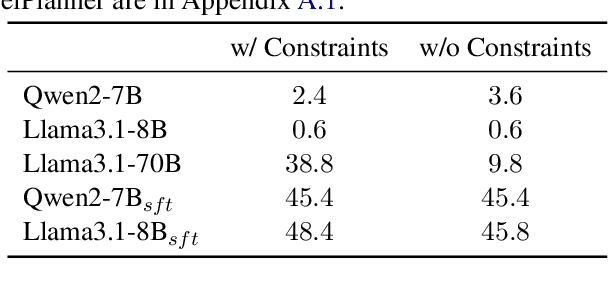

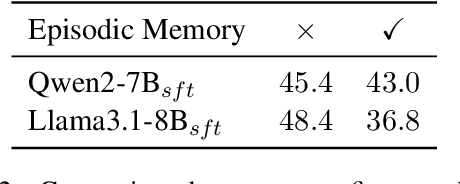
Abstract:Autonomous planning has been an ongoing pursuit since the inception of artificial intelligence. Based on curated problem solvers, early planning agents could deliver precise solutions for specific tasks but lacked generalization. The emergence of large language models (LLMs) and their powerful reasoning capabilities has reignited interest in autonomous planning by automatically generating reasonable solutions for given tasks. However, prior research and our experiments show that current language agents still lack human-level planning abilities. Even the state-of-the-art reasoning model, OpenAI o1, achieves only 15.6% on one of the complex real-world planning benchmarks. This highlights a critical question: What hinders language agents from achieving human-level planning? Although existing studies have highlighted weak performance in agent planning, the deeper underlying issues and the mechanisms and limitations of the strategies proposed to address them remain insufficiently understood. In this work, we apply the feature attribution study and identify two key factors that hinder agent planning: the limited role of constraints and the diminishing influence of questions. We also find that although current strategies help mitigate these challenges, they do not fully resolve them, indicating that agents still have a long way to go before reaching human-level intelligence.
OlympicArena: Benchmarking Multi-discipline Cognitive Reasoning for Superintelligent AI
Jun 18, 2024
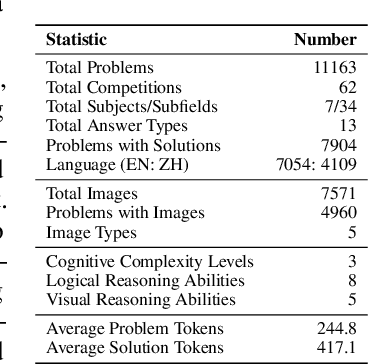
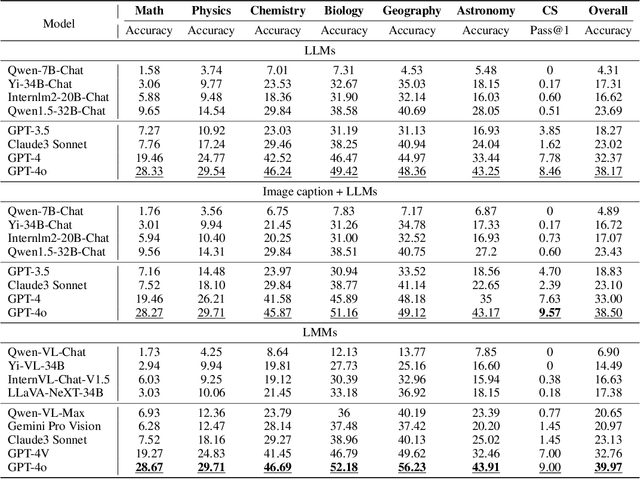
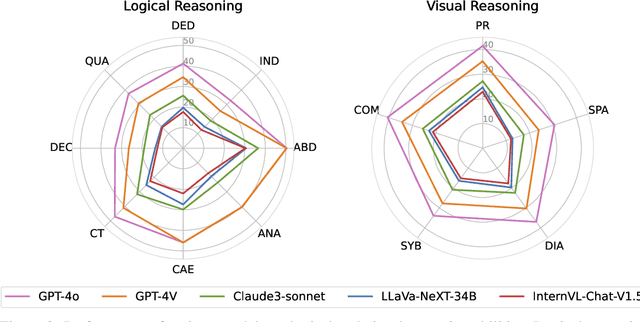
Abstract:The evolution of Artificial Intelligence (AI) has been significantly accelerated by advancements in Large Language Models (LLMs) and Large Multimodal Models (LMMs), gradually showcasing potential cognitive reasoning abilities in problem-solving and scientific discovery (i.e., AI4Science) once exclusive to human intellect. To comprehensively evaluate current models' performance in cognitive reasoning abilities, we introduce OlympicArena, which includes 11,163 bilingual problems across both text-only and interleaved text-image modalities. These challenges encompass a wide range of disciplines spanning seven fields and 62 international Olympic competitions, rigorously examined for data leakage. We argue that the challenges in Olympic competition problems are ideal for evaluating AI's cognitive reasoning due to their complexity and interdisciplinary nature, which are essential for tackling complex scientific challenges and facilitating discoveries. Beyond evaluating performance across various disciplines using answer-only criteria, we conduct detailed experiments and analyses from multiple perspectives. We delve into the models' cognitive reasoning abilities, their performance across different modalities, and their outcomes in process-level evaluations, which are vital for tasks requiring complex reasoning with lengthy solutions. Our extensive evaluations reveal that even advanced models like GPT-4o only achieve a 39.97% overall accuracy, illustrating current AI limitations in complex reasoning and multimodal integration. Through the OlympicArena, we aim to advance AI towards superintelligence, equipping it to address more complex challenges in science and beyond. We also provide a comprehensive set of resources to support AI research, including a benchmark dataset, an open-source annotation platform, a detailed evaluation tool, and a leaderboard with automatic submission features.
DetectBench: Can Large Language Model Detect and Piece Together Implicit Evidence?
Jun 18, 2024



Abstract:Detecting evidence within the context is a key step in the process of reasoning task. Evaluating and enhancing the capabilities of LLMs in evidence detection will strengthen context-based reasoning performance. This paper proposes a benchmark called DetectBench for verifying the ability to detect and piece together implicit evidence within a long context. DetectBench contains 3,928 multiple-choice questions, with an average of 994 tokens per question. Each question contains an average of 4.55 pieces of implicit evidence, and solving the problem typically requires 7.62 logical jumps to find the correct answer. To enhance the performance of LLMs in evidence detection, this paper proposes Detective Reasoning Prompt and Finetune. Experiments demonstrate that the existing LLMs' abilities to detect evidence in long contexts are far inferior to humans. However, the Detective Reasoning Prompt effectively enhances the capability of powerful LLMs in evidence detection, while the Finetuning method shows significant effects in enhancing the performance of weaker LLMs. Moreover, when the abilities of LLMs in evidence detection are improved, their final reasoning performance is also enhanced accordingly.
Light Up the Shadows: Enhance Long-Tailed Entity Grounding with Concept-Guided Vision-Language Models
Jun 16, 2024Abstract:Multi-Modal Knowledge Graphs (MMKGs) have proven valuable for various downstream tasks. However, scaling them up is challenging because building large-scale MMKGs often introduces mismatched images (i.e., noise). Most entities in KGs belong to the long tail, meaning there are few images of them available online. This scarcity makes it difficult to determine whether a found image matches the entity. To address this, we draw on the Triangle of Reference Theory and suggest enhancing vision-language models with concept guidance. Specifically, we introduce COG, a two-stage framework with COncept-Guided vision-language models. The framework comprises a Concept Integration module, which effectively identifies image-text pairs of long-tailed entities, and an Evidence Fusion module, which offers explainability and enables human verification. To demonstrate the effectiveness of COG, we create a dataset of 25k image-text pairs of long-tailed entities. Our comprehensive experiments show that COG not only improves the accuracy of recognizing long-tailed image-text pairs compared to baselines but also offers flexibility and explainability.
SelfGoal: Your Language Agents Already Know How to Achieve High-level Goals
Jun 07, 2024



Abstract:Language agents powered by large language models (LLMs) are increasingly valuable as decision-making tools in domains such as gaming and programming. However, these agents often face challenges in achieving high-level goals without detailed instructions and in adapting to environments where feedback is delayed. In this paper, we present SelfGoal, a novel automatic approach designed to enhance agents' capabilities to achieve high-level goals with limited human prior and environmental feedback. The core concept of SelfGoal involves adaptively breaking down a high-level goal into a tree structure of more practical subgoals during the interaction with environments while identifying the most useful subgoals and progressively updating this structure. Experimental results demonstrate that SelfGoal significantly enhances the performance of language agents across various tasks, including competitive, cooperative, and deferred feedback environments. Project page: https://selfgoal-agent.github.io.
 Add to Chrome
Add to Chrome Add to Firefox
Add to Firefox Add to Edge
Add to Edge